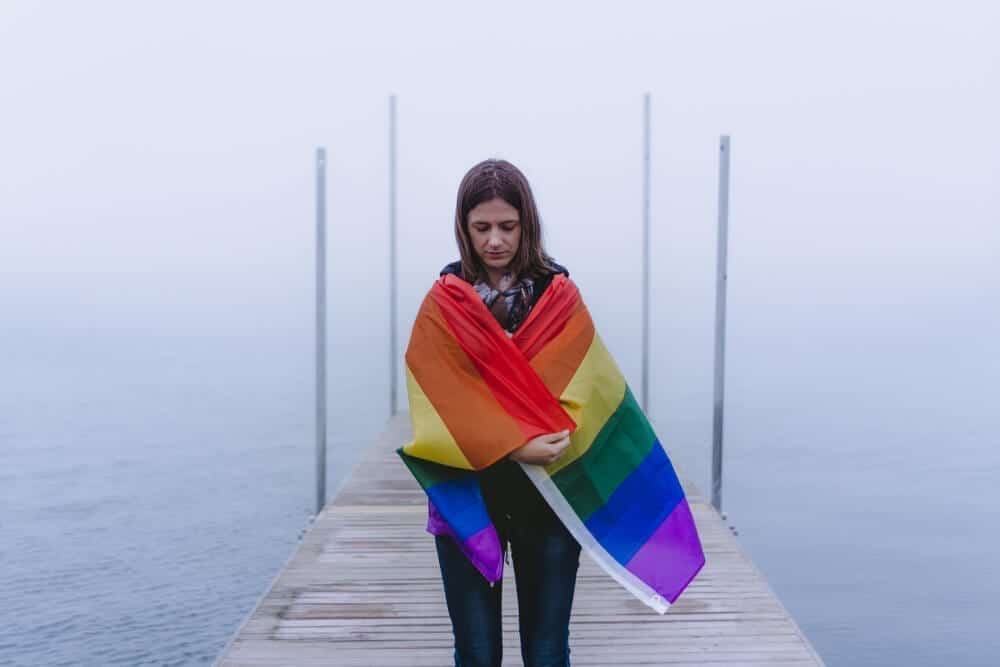
When you picture someone with an eating disorder, what do you see? We often think of eating disorders as a disease affecting white, wealthy, cis-gendered teenage girls — when in reality, the breadth of who can be diagnosed with an eating disorder stretches far wider.
In fact, the LGBTQ community is disproportionately affected by eating disorders. Studies have found that as early as age 12, gay, lesbian and bisexual tweens may be at higher risk of binge-eating and purging behaviors than their heterosexual peers.
So, why does the LGBTQ community suffer from eating disorders at such an alarming rate? And who in the community is most likely to be afflicted by them? This post explores the power of body image and eating disorders in the LGBTQ community — and why we should care.
Why Are LGBTQ Youth at Higher Risk of Eating Disorders?
Unfortunately, we live in a world that hasn’t fully accepted the LGBTQ community. Children recognize their sociocultural differences at a young age, putting them at a higher risk of mental health problems like eating disorders.
Some of the reasons why LGBTQ youth may be disproportionately affected by eating disorders stem from stigma, while others result from the bullying and violence that LGBTQ youth are often subjected to.
Here are just a sampling of the factors that increase the risk of an LGBTQ teenager developing an eating disorder, according to the National Eating Disorders Association (NEDA):
- Fear of rejection by family, friends and/or co-workers
- Internalized negative beliefs about themselves and/or their sexual orientation
- Experiences of violence and Post-Traumatic Stress Disorder (PTSD)
- Discrimination due to one’s sexuality and/or gender identity
- Discordance between one’s biological sex and gender identity
- Inability to meet body ideals within some LGBTQ cultural contexts
Evidence also shows that LGBTQ youth experience higher risks of homelessness and unsafe home environments. According to NEDA, as much as 42% of homeless youth are LGBTQ, and 33% of homeless youth and youth in foster care experienced violent assault when they came out. This history of violence and instability may put LGBTQ youth at higher risk of mental health issues, including but not limited to eating disorders.
Other Risk and Protective Factors for Developing Eating Disorders
Being LGBTQ does not guarantee a person will develop an eating disorder, nor does being straight protect someone from developing one. Other risk factors exist. Combined with membership in the LGBTQ community, these additional risk factors may compound the probability that a person will develop an eating disorder.
One example? Among LGBTQ youth, Black and Latinx members of the LGBTQ+ community had an even higher risk of developing an eating disorder than their white peers. This suggests that race is an additional factor contributing to the development of eating disorders.
Other factors may protect members of the LGBTQ community from developing eating disorders. For example, one study found that a sense of belonging to the gay community may serve as an insulating factor protecting against the development of eating disorders, while a weak sense of belonging to the gay community may predispose an LGBTQ person to develop an eating disorder.
LGBTQ Populations at the Highest Risk of Eating Disorders
As you can see, eating disorder risk is not equal, even within the LGBTQ community. While the LGBTQ community has a higher collective risk of developing an eating disorder, not every LGBTQ person will go on to develop an eating disorder — and some are more likely to suffer than others.
Gay and Bisexual Men and Eating Disorders
You may not think of men as the typical eating disorder patients, but as many as ¼ of those diagnosed with an eating disorder are male, according to U.K. charity BEAT.
Compared with heterosexual males, gay and bisexual men are at far higher risk of developing an eating disorder. More than 15% of gay and bisexual men exhibit signs of disordered eating, writes Eating Disorder Hope.
Eating disorders may be especially common in gay, versus bisexual, men in the LGBTQ community. According to NEDA, gay males represent only 5% of the general population, but among males with eating disorders, 42% identify as gay.
Gay men are seven times more likely to report binging and 12 times more likely to report purging than their heterosexual peers, suggesting they are at especially high risk of developing the eating disorder known as bulimia nervosa, characterized by alternating binging and purging behaviors.
Being gay is also traditionally associated with the development of anorexia nervosa in men. Some suggest that this correlation is due to the heightened awareness of eating disorder behaviors in the LGBTQ community and that gay men may not actually develop anorexia nervosa more often, although they may seek treatment for it more often than their heterosexual peers.
Why are gay men at such a high risk of developing eating disorders? Some research suggests that men’s bodies are objectified within the gay community the same way that women’s bodies are objectified within the straight community, inviting excessive scrutiny and obsessive body-checking.
Other studies of LGBTQ men have found that a history of childhood sexual abuse was linked to the expression of subclinical eating disorder behaviors, suggesting eating disorder behaviors may develop as a coping mechanism for dealing with this childhood trauma. Based on the study, however, it’s unclear whether the higher eating disorder risk is due to this history of childhood sexual abuse or whether being LGBTQ put these men at higher risk of experiencing childhood sexual abuse.
Lesbian and Bisexual Women’s Risk of Eating Disorders
According to NEDA, the research on lesbian and bisexual women and eating disorders is limited — and often conflicting. For example, while studies suggest that lesbians experience lower body dissatisfaction as a whole, research also shows that gay and bisexual teens are at higher risk of developing binging and purging behavior than their heterosexual peers, regardless of their gender.
Binge-eating may be of particular concern among lesbian and bisexual women in the LGBTQ community. Females who identified as lesbian or bisexual were twice as likely to report binging as their heterosexual peers, according to NEDA. Another study found that this behavior also applied to LGBTQ males, suggesting a correlation between the LGBTQ community and risk of binge-eating.
These binging and purging behaviors, however, may be subclinical. In 2007, a study was conducted that assessed eating disorder diagnoses according to the DSM-V criteria and their relationship to sexual orientation. This study found no difference between heterosexual women’s risk of developing an eating disorder and bisexual and lesbian women’s risk of developing an eating disorder.
Transgender vs. Cisgender Individuals and Eating Disorder Risk
Eating disorders also do not discriminate against transgender individuals, who represent 0.6% of the United States population.
Someone who identifies as transgender feels like a member of the opposite sex; in other words, they are born in a body and/or assigned a gender at birth that does not match their gender identity. The opposite of transgender is cisgender, referring to someone whose gender identity matches the gender they were assigned at birth. (Note that these terms do not say anything about their sexual orientation, which may or may not be heterosexual, homosexual or bisexual.)
Research shows that transgender individuals are at much higher risk of developing an eating disorder than their cisgender peers. For example, a 2015 study of transgender college students found that they were four times more likely than cisgender females to report an eating disorder diagnosis such as anorexia or bulimia.
Transgender individuals are also more likely to report eating disorder behaviors like binging and purging than their cisgender counterparts. For example, a 2013 study of high school youth found that transgender students were three times as likely as cisgender students to restrict their food intake, nine times as likely to use diet pills and seven times as likely to use laxatives to control their weight.
So, why do transgender individuals suffer from eating disorders at such alarming rates? One explanation is gender dysphoria, or the psychological diagnosis used to express the dischord a transgender person feels between their body and their gender identity.
These feelings may lead a transgender person to want to change their body to better match the way they view themselves in their head. For example, male-to-female transgender individuals may restrict to achieve a more feminine appearance, while female-to-male transgender individuals may do so to suppress female characteristics such as menstruation.
Another potential explanation is the high rate of trauma among transgender individuals in the LGBTQ. Identifying as transgender predisposes a person to suffering from the effects of stigma, including violence and bullying, which may also contribute to an increased risk of developing an eating disorder.
Barriers to Accessing Eating Disorder Treatment in the LGBTQ Community

Despite the fact that LGBTQ individuals suffer from eating disorders at higher rates than their heterosexual and/or cisgender peers, evidence suggests they may experience barriers to accessing adequate treatment for their eating disorder thoughts and behaviors.
According to NEDA, some of these barriers to treatment include:
- Lack of culturally-competent treatment that addresses the complexity of sexuality and gender identity issues
- Lack of family and/or friend support, if not a part of an accepting community
- Insufficient eating disorder education among LGBTQ resource providers, who might otherwise intervene
Thankfully, the emergence of LGBTQ-focused resource centers for physical and mental health has helped increase access to eating disorder treatment among the LGBTQ community. Sadly, however, many LGBTQ people still belong to communities that may not be as accepting and/or do not offer these resources.
Here at The Meadowglade, we offer culturally-competent care for members of the LGBTQ community. Whether you identify as homosexual, bisexual, transgender or non-binary, we will listen to your concerns with sensitivity and work to address issues of sexuality and gender identity in your treatment program for an eating disorder.
